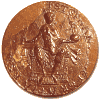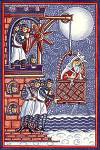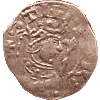In 1126, the nobles acknowledged Maud as King Henry's successor but when King Henry I died in 1135, Stephen hurried to England and was declared king much in the same way that Henry I took the throne 35 years before.
Most of the barons declared for Stephen, partly because they had been fighting against Maud and her claims for Normandy and because she was a woman, partly because her son was still an infant and Stephen was on the spot.
 In 1135 when Stephen hurried to England, some of the towns in Eastern England, Colchester and Ramsey, refused to allow him entrance. This is considered to be the true beginning of the civil war. In 1135 Stephen was elected and crowned king in Westminster. In 1136 he put down rebellions in Scotland, Wales, Norfolk and Devon. As yet Maud had not begun to contest for the throne. In 1138, Stephen took the castle of Shrewsbury and held it for the rest of the war. Maud was supported by David I of Scotland and her half-brother Robert, Earl of Gloucester. The regime in the areas she controlled was harsh. In 1135 when Stephen hurried to England, some of the towns in Eastern England, Colchester and Ramsey, refused to allow him entrance. This is considered to be the true beginning of the civil war. In 1135 Stephen was elected and crowned king in Westminster. In 1136 he put down rebellions in Scotland, Wales, Norfolk and Devon. As yet Maud had not begun to contest for the throne. In 1138, Stephen took the castle of Shrewsbury and held it for the rest of the war. Maud was supported by David I of Scotland and her half-brother Robert, Earl of Gloucester. The regime in the areas she controlled was harsh.

By 1141, the Earl of Chester rebeled, not for Maud but for his own kingdom. He defeated and captured Stephen, who was imprisoned in Winchester. Winchester was the place where the treasury was held, and was counted as important as London as a capital of England at that time.
 Maud came to England, and in April 1141, she was declared “Mother of England” (Domina Anglorum) by Stephens brother bishop Henry of Blois who had changed ends. Maud came to England, and in April 1141, she was declared “Mother of England” (Domina Anglorum) by Stephens brother bishop Henry of Blois who had changed ends.
But she was not yet crowned in Westminster and the archbishop of Canterbury still supported king Stephen.
Stephens wife, Matilda began to gather troops to free her husband, but was unexpectedly assisted by Maud when she angered the burgesses of London and was literally forced to flee for her life.
 She ended up in Oxford. By this time Stephen had been traded for her half-brother Robert of Gloucester, and pined her down in Oxford, but she daringly escaped to Wallingford, and on to fight again. The fighting went on back and forth, and in 1143 Stephen was defeated by Robert of Gloucester, and in 1145 Robert was cut off by Stephen and fled to France where he died in 1148. In the same year, Maud retired to Normandy, which her husband had won in 1144. Her eldest son Henry upheld her cause in England. She ended up in Oxford. By this time Stephen had been traded for her half-brother Robert of Gloucester, and pined her down in Oxford, but she daringly escaped to Wallingford, and on to fight again. The fighting went on back and forth, and in 1143 Stephen was defeated by Robert of Gloucester, and in 1145 Robert was cut off by Stephen and fled to France where he died in 1148. In the same year, Maud retired to Normandy, which her husband had won in 1144. Her eldest son Henry upheld her cause in England.
Little fighting went on after 1148.
Stephen was really defeated by the death of his strongest supporter, his wife Matilda, in 1151 and the death of his son Eustace in 1153. He finally accepted Maud's son Henry as his successor in the treaty of Wallingford whereby Stephen would remain king for life and accept Henry as his heir.
 So the war was ended by compromise and the inability of either side to win a definitive victory, Stephen because of his inconsistency, Maud because of her temper. Meantime, Geoffrey of Anjou had consolidated his hold on much of France by taking Normandy, so that when Henry II came to the throne, he held Anjou and Normandy and married Aquitaine and Poitou, holding about three quarters of modern France. So the war was ended by compromise and the inability of either side to win a definitive victory, Stephen because of his inconsistency, Maud because of her temper. Meantime, Geoffrey of Anjou had consolidated his hold on much of France by taking Normandy, so that when Henry II came to the throne, he held Anjou and Normandy and married Aquitaine and Poitou, holding about three quarters of modern France.
Stephen died at Dover Castle in 1154, nine months after the treaty was signed. He was buried with his wife and son at Faversham Abbey, which he founded.
Henry II became king of England in 1154. In the terms of the treaty of Wallingford, the barons kept their titles and lands, regardless whose side they fought on. Maud only revisited England once in 1155.

She died at Rouen on 10th September 1167 and was buried at Bec Abbey. Her coffin, rediscovered in 1846, was reinterred in Rouen Cathedral. Her tomb inscription is said to have run: “Here lies Henry's daughter, wife, and mother; great by birth, greater by marriage, but greatest by motherhood.”
Henry II inherited a land of strife and little law. He consolidated his rule, strengthened the laws, and made “the kings peace” very strong. The highways were safe to travel again, outlawry was almost snuffed out and courts strengthened.
|